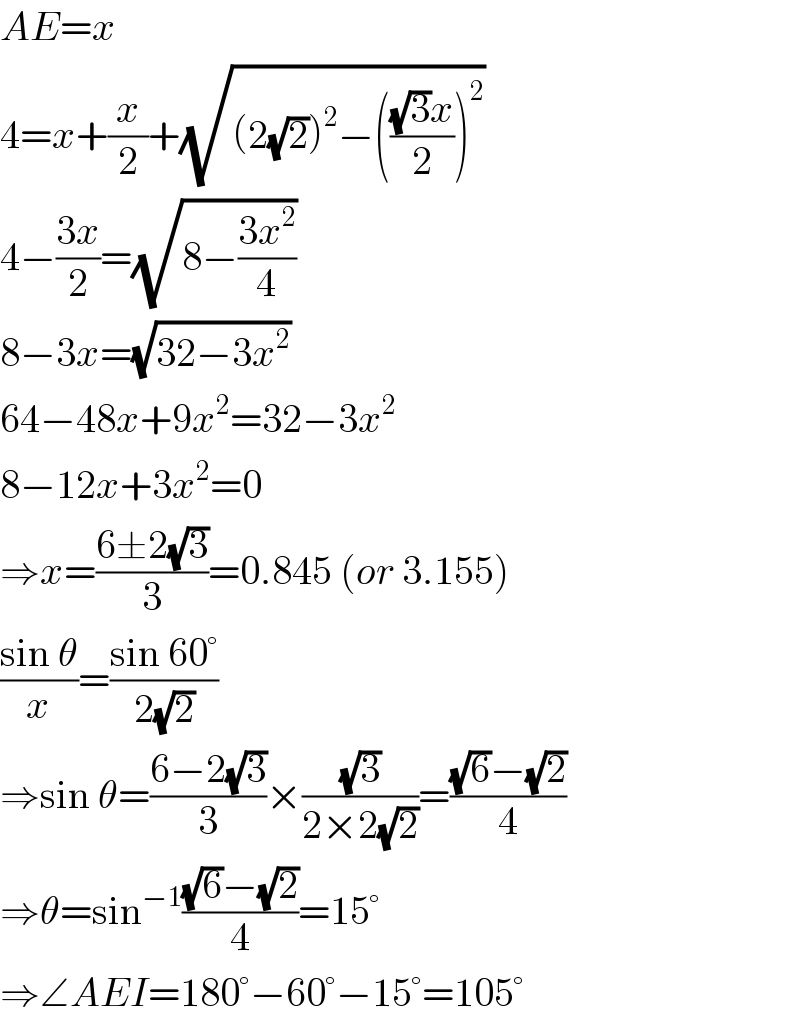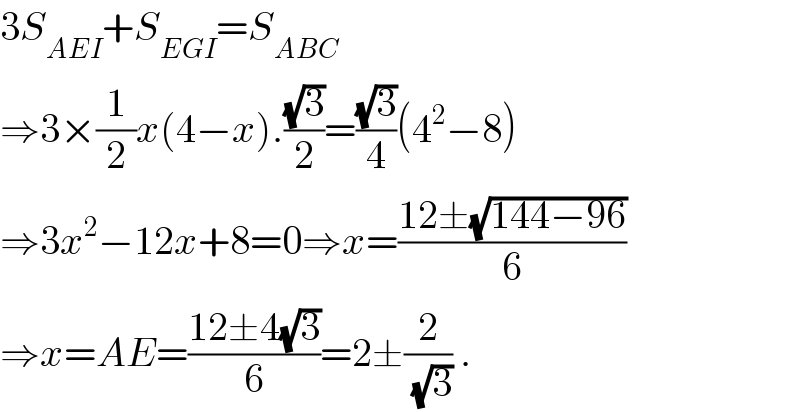
Question Number 49530 by behi83417@gmail.com last updated on 07/Dec/18

Commented by behi83417@gmail.com last updated on 07/Dec/18
![△ and △ are equilateral triangles. AB=4,EG=2(√2) [or:AB=6,EG=2(√6)] ⇒ AE=? , ∡AEI=?](Q49531.png)
$$\bigtriangleup\:{and}\:\bigtriangleup\:{are}\:{equilateral}\:{triangles}. \\ $$$${AB}=\mathrm{4},{EG}=\mathrm{2}\sqrt{\mathrm{2}}\:\:\:\left[{or}:{AB}=\mathrm{6},{EG}=\mathrm{2}\sqrt{\mathrm{6}}\right] \\ $$$$\Rightarrow\:\:\:\:\:{AE}=?\:\:\:\:,\:\:\:\:\:\measuredangle{AEI}=? \\ $$
Commented by mr W last updated on 07/Dec/18

$${not}\:{possible}\:{sir}! \\ $$$${EG}\geqslant{AB}/\mathrm{2}=\mathrm{6}/\mathrm{2}=\mathrm{3} \\ $$$$\Rightarrow{with}\:{EG}=\sqrt{\mathrm{6}}<\mathrm{3}\:{no}\:{solution}! \\ $$
Commented by behi83417@gmail.com last updated on 07/Dec/18

$${yes}\:{sir}.{you}\:{are}\:{right}.{values}\:{changed}. \\ $$
Answered by mr W last updated on 07/Dec/18

$${AE}={x} \\ $$$$\mathrm{4}={x}+\frac{{x}}{\mathrm{2}}+\sqrt{\left(\mathrm{2}\sqrt{\mathrm{2}}\right)^{\mathrm{2}} −\left(\frac{\sqrt{\mathrm{3}}{x}}{\mathrm{2}}\right)^{\mathrm{2}} } \\ $$$$\mathrm{4}−\frac{\mathrm{3}{x}}{\mathrm{2}}=\sqrt{\mathrm{8}−\frac{\mathrm{3}{x}^{\mathrm{2}} }{\mathrm{4}}} \\ $$$$\mathrm{8}−\mathrm{3}{x}=\sqrt{\mathrm{32}−\mathrm{3}{x}^{\mathrm{2}} } \\ $$$$\mathrm{64}−\mathrm{48}{x}+\mathrm{9}{x}^{\mathrm{2}} =\mathrm{32}−\mathrm{3}{x}^{\mathrm{2}} \\ $$$$\mathrm{8}−\mathrm{12}{x}+\mathrm{3}{x}^{\mathrm{2}} =\mathrm{0} \\ $$$$\Rightarrow{x}=\frac{\mathrm{6}\pm\mathrm{2}\sqrt{\mathrm{3}}}{\mathrm{3}}=\mathrm{0}.\mathrm{845}\:\left({or}\:\mathrm{3}.\mathrm{155}\right) \\ $$$$\frac{\mathrm{sin}\:\theta}{{x}}=\frac{\mathrm{sin}\:\mathrm{60}°}{\mathrm{2}\sqrt{\mathrm{2}}} \\ $$$$\Rightarrow\mathrm{sin}\:\theta=\frac{\mathrm{6}−\mathrm{2}\sqrt{\mathrm{3}}}{\mathrm{3}}×\frac{\sqrt{\mathrm{3}}}{\mathrm{2}×\mathrm{2}\sqrt{\mathrm{2}}}=\frac{\sqrt{\mathrm{6}}−\sqrt{\mathrm{2}}}{\mathrm{4}} \\ $$$$\Rightarrow\theta=\mathrm{sin}^{−\mathrm{1}} \frac{\sqrt{\mathrm{6}}−\sqrt{\mathrm{2}}}{\mathrm{4}}=\mathrm{15}° \\ $$$$\Rightarrow\angle{AEI}=\mathrm{180}°−\mathrm{60}°−\mathrm{15}°=\mathrm{105}° \\ $$
Commented by behi83417@gmail.com last updated on 07/Dec/18

$${right}\:{answer}\:{and}\:{perfect}\:{way}. \\ $$$${thank}\:{you}\:{very}\:{much}\:{dear}\:{master}. \\ $$
Answered by behi83417@gmail.com last updated on 07/Dec/18
![EG^2 =GB^2 +EB^2 −2GB.EB.cos60 (2(√2))^2 =x^2 +(4−x)^2 −2x(4−x).(1/2) 3x^2 −12x+8=0⇒x=AE=((12±(√(144−96)))/6) AE=((12±4(√3))/6)=2±(2/(√3)) .[=0.845 ∨ 3.15] cosAE^� I=(((2(√2))^2 +x^2 −(4−x)^2 )/(4(√2)x))= =((8+x^2 −x^2 +8x−16)/(4(√2)x))=(√2)(1−(1/x))= =(√2)(1−(1/(0.845)))=−0.259⇒AE^� I=105^• .](Q49547.png)
$${EG}^{\mathrm{2}} ={GB}^{\mathrm{2}} +{EB}^{\mathrm{2}} −\mathrm{2}{GB}.{EB}.{cos}\mathrm{60} \\ $$$$\left(\mathrm{2}\sqrt{\mathrm{2}}\right)^{\mathrm{2}} ={x}^{\mathrm{2}} +\left(\mathrm{4}−{x}\right)^{\mathrm{2}} −\mathrm{2}{x}\left(\mathrm{4}−{x}\right).\frac{\mathrm{1}}{\mathrm{2}} \\ $$$$\mathrm{3}{x}^{\mathrm{2}} −\mathrm{12}{x}+\mathrm{8}=\mathrm{0}\Rightarrow{x}={AE}=\frac{\mathrm{12}\pm\sqrt{\mathrm{144}−\mathrm{96}}}{\mathrm{6}} \\ $$$${AE}=\frac{\mathrm{12}\pm\mathrm{4}\sqrt{\mathrm{3}}}{\mathrm{6}}=\mathrm{2}\pm\frac{\mathrm{2}}{\sqrt{\mathrm{3}}}\:.\left[=\mathrm{0}.\mathrm{845}\:\vee\:\mathrm{3}.\mathrm{15}\right] \\ $$$${cosA}\overset{�} {{E}I}=\frac{\left(\mathrm{2}\sqrt{\mathrm{2}}\right)^{\mathrm{2}} +{x}^{\mathrm{2}} −\left(\mathrm{4}−{x}\right)^{\mathrm{2}} }{\mathrm{4}\sqrt{\mathrm{2}}{x}}= \\ $$$$=\frac{\mathrm{8}+{x}^{\mathrm{2}} −{x}^{\mathrm{2}} +\mathrm{8}{x}−\mathrm{16}}{\mathrm{4}\sqrt{\mathrm{2}}{x}}=\sqrt{\mathrm{2}}\left(\mathrm{1}−\frac{\mathrm{1}}{{x}}\right)= \\ $$$$=\sqrt{\mathrm{2}}\left(\mathrm{1}−\frac{\mathrm{1}}{\mathrm{0}.\mathrm{845}}\right)=−\mathrm{0}.\mathrm{259}\Rightarrow{A}\overset{�} {{E}I}=\mathrm{105}^{\bullet} . \\ $$
Answered by behi83417@gmail.com last updated on 07/Dec/18

$$\mathrm{3}{S}_{{AEI}} +{S}_{{EGI}} ={S}_{{ABC}} \\ $$$$\Rightarrow\mathrm{3}×\frac{\mathrm{1}}{\mathrm{2}}{x}\left(\mathrm{4}−{x}\right).\frac{\sqrt{\mathrm{3}}}{\mathrm{2}}=\frac{\sqrt{\mathrm{3}}}{\mathrm{4}}\left(\mathrm{4}^{\mathrm{2}} −\mathrm{8}\right) \\ $$$$\Rightarrow\mathrm{3}{x}^{\mathrm{2}} −\mathrm{12}{x}+\mathrm{8}=\mathrm{0}\Rightarrow{x}=\frac{\mathrm{12}\pm\sqrt{\mathrm{144}−\mathrm{96}}}{\mathrm{6}} \\ $$$$\Rightarrow{x}={AE}=\frac{\mathrm{12}\pm\mathrm{4}\sqrt{\mathrm{3}}}{\mathrm{6}}=\mathrm{2}\pm\frac{\mathrm{2}}{\sqrt{\mathrm{3}}}\:. \\ $$
